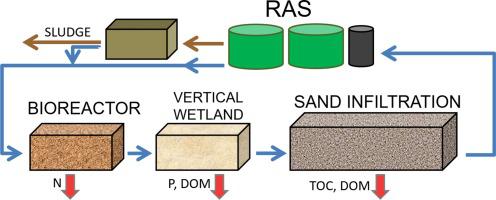Aquacultural Engineering ( IF 3.6 ) Pub Date : 2021-04-02 , DOI: 10.1016/j.aquaeng.2021.102161 Jani T. Pulkkinen , Anna-Kaisa Ronkanen , Antti Pasanen , Sepideh Kiani , Tapio Kiuru , Juha Koskela , Petra Lindholm-Lehto , Antti-Jussi Lindroos , Muhammad Muniruzzaman , Lauri Solismaa , Björn Klöve , Jouni Vielma

|
Recirculating aquaculture systems (RAS) discharge management limits the development of the aquaculture sector, because RAS do not automatically result in low nutrient emissions. Research has helped develop discharge management systems such as wetlands and woodchip bioreactors that have been adopted by Danish commercial model trout farms. To further develop the Danish concept, we have modelled and built a novel “zero-discharge” recirculating aquaculture system with an annual capacity of approximately 14 tonnes. The aim of this paper is to describe the entire concept and present the results from the start-up phase of the whole system. The concept includes the treatment of RAS effluent (overflow and sludge supernatant) using a hybrid solution of a woodchip bioreactor, constructed vertical wetland, and sand infiltration. Using this three-step process, the nitrate, phosphorus, and organic matter effluent are decreased to acceptable levels to reuse the water in the RAS process reducing the need for new raw water. In the first nine months of operation, a water treatment field was used as an end-of-pipe treatment to ensure the water was safe to recirculate for fish. During the winter, the water temperature dropped to 2.7 degrees in the sand filter, but the frost did not reach the water levels in any of the treatment processes. It therefore appears that a hybrid solution can operate sufficiently even in winter conditions. In the first year of operation, a woodchip bioreactor can remove 97 % of the nitrate, although the slow start-up of the RAS caused the bioreactor to be N-limited. On average, 79 % and 92 % of the inflow phosphate concentration was removed in the woodchip bioreactor and the entire hybrid treatment field respectively. The wetland and sand filter removed organic matter sufficiently (35 %), but because of the longer than designed actual water residence, it leached from the bioreactor more than was expected. Further experimentation is needed to identify the financial applicability and performance during higher feeding rates.
中文翻译:

启动使用木片反硝化,人工湿地和沙土渗透的“零排放”循环水产养殖系统
循环水产养殖系统(RAS)的排放管理限制了水产养殖部门的发展,因为RAS不会自动导致低养分排放。研究帮助开发了排放管理系统,例如湿地和木片生物反应器,这些系统已被丹麦商业鳟鱼养殖场采用。为了进一步发展丹麦的概念,我们建模并建立了一个新型的“零排放”循环水产养殖系统,其年产能约为14吨。本文的目的是描述整个概念,并介绍整个系统启动阶段的结果。该概念包括使用木片生物反应器,人工建造的垂直湿地和沙土渗透的混合溶液处理RAS废水(溢流和污泥上清液)。使用此三步过程,硝酸盐,磷和有机物的排放降低到可接受的水平,以在RAS过程中再利用水,从而减少了对新原水的需求。在运营的前九个月中,水处理场被用作管道末端处理,以确保水可以安全地循环用于鱼类。在冬季,沙滤器中的水温降至2.7度,但在任何处理过程中霜霜均未达到水位。因此看来,即使在冬季条件下,混合解决方案也可以充分运行。在运行的第一年,木片生物反应器可以去除97%的硝酸盐,尽管RAS的缓慢启动导致生物反应器受到N限制。一般,在木片生物反应器和整个混合处理场中分别去除了79%和92%的流入磷酸盐浓度。湿地和沙滤池可充分去除有机物(35%),但是由于比实际设计的水停留时间长,因此从生物反应器中沥滤的水量超出了预期。需要进行进一步的实验来确定较高喂食率期间的财务适用性和性能。











































 京公网安备 11010802027423号
京公网安备 11010802027423号